DARIUS THE GREAT, Part I - Administrating an Empire
Go and check out my previous blog on the Conspiracy of the Seven to see how Darius came to power:
https://steemit.com/hive-133974/@oo7harv/the-conspiracy-of-the-seven-from-cambyses-to-darius
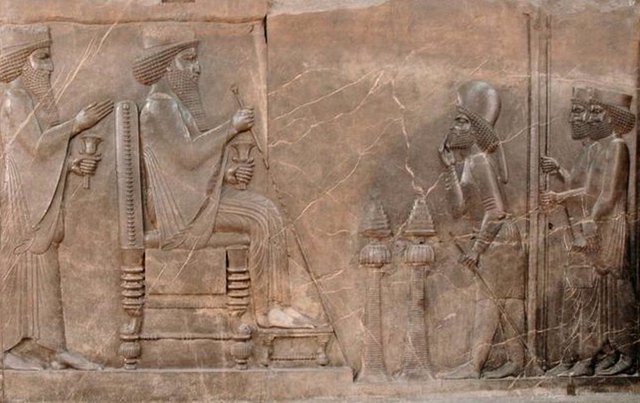
[ABOVE: Relief stone depicting Darius the Great, the Behistun Inscription]
Born in 550 BC, Darius came to the throne following the Conspiracy of the Seven in 522 BC at the age of 28. He would rapidly go on to prove himself a more than competent military commander and a brilliant administrator of his empire. His opportunity to prove himself came very early on in his reign; rebellions started through many people in the empire being in suspicion of him being a usurper, and Darius would spend three years putting them down with the aid of the royal household guard, known to the Greeks as the Immortals, so-called as their number seemed to never drop below ten-thousand. His conquests brought the empire to what would remain its territorial height, stretching from the Indus River in the east to the Bosphorus Straights - which separate mainland Europe from Asia - in the west.
With thanks to Cyrus and Cambyses, all peoples of Asia - except the allied Arabians - were now subject to the Persians. Darius's first act as king was to marry Cyrus’ two daughters: Atossa (previously married to Cambyses and then the Magi) and Artystone, as well as Parmys, the daughter of Cyrus’ son Smerdis, as well as the daughter of Otanes. He also ordered the erection of a stone statue of a man on horseback with the inscription:
“Darius the son of Hystaspes gained the Persian kingdom through the prowess of his horse.”
He added the name of the horse, as well as Oebares, the groom.
ADMINISTRATING HIS EMPIRE
SATRAPS AND SATRAPIES
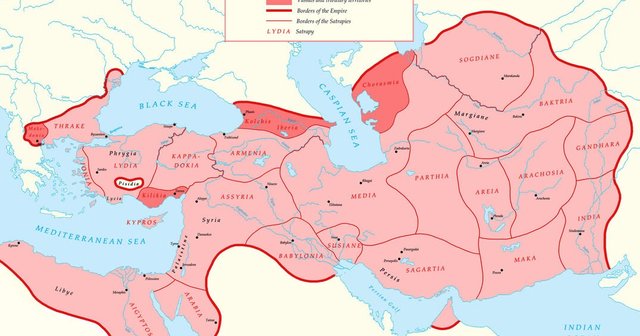
[ABOVE: The 20 Satrapies under Darius the Great]
His next act was the establishment of the empire’s 20 satrapies, each governed by their own satrap. Once this was achieved, he set about establishing the tribute required from each satrapy; Satraps were the officials and satrapies were the provinces they governed, and the satraps had minimal interference from their higher-ups. Darius also set up the annual tax due from each satrapy, appointing agents, known as the “eyes of the king”, to overlook the satraps to make sure they weren’t overtaxing their citizens. Darius issued coins to facilitate trade and taxation further, a practice he took on from Croesus and the Lydian’s before, but unlike silver and gold ingots which needed to be weight to determine their worth, Darius’s coins, showing him as a warrior, had uniform values, making exchanges much easier. Those who paid in silver were to use the Babylonian Talent, while those paying up in gold were made to use the Euboïc talent.
With no system like this in place prior to his reign, Darius was often described as a retailer, while Cambyses was described as a master, having been “the cruel one”, and Cyrus was known as the father.
As per according to Herodotus in Book 3, I will now lest the 20 satrapies in order, and the amount of silver they were made to pay in tribute to the Persian king every year:
Ionians, Asian Magnesians, Aeolians, Carians, Lycians, Milyans and Pamphylians were made to pay 400 talents of silver.
Mysians, Lydians, Lasonians, Cabalians and Hytenneans contributed 500 talents.
Phrygians, Thracians, Paphlagonians, Mariandynians and Syrians were made to pay 360 talents.
Cilicians were made to pay 360 white horses a year and 500 silver talents, 140 of which went towards the cavalry’s upkeep in Cilicia. The rest went to the king himself.
The fifth satrapy was a region stretching from northern Syria down to the borders of Egypt, including Cyprus but excluding Arabia, and they were made to pay 350 talents.
Egypt, Libya and Cyrene together contributed 700 talents.
Sattagydae, Gandarians, Dadicae and the Aparytae tribes living to the east of Persia contributed 170 talents.
Susa, and the land of the Cissians, contributed 300 talents.
Babylon and surrounding Assyria contributed 1,000 talents, as well as 500 child eunuchs.
Media and the city of Ecbatana contributed 450 talents in total.
Various tribes around the Caspian Sea in northern Iran contributed 200 talents.
Bactria’s tribute totalled 360 talents.
The region around the Euxine Sea, including Armenia, contributed 400 talents.
Peoples around the Red Sea, including its many island communities, contributed 600 talents.
The Sacae and other east Caspian tribes handed in 250 talents of silver in tribute.
Parthians, Chorasmians, Sogdians and Arians contributed 300 talents.
Paricanians and Asiatic Ethiopians contributed 400 talents.
Matieneans, Saspeires and Alarodians contributed 200 talents.
Macrones, Mares, Moschians, Mossynoecians and Tibarenians together contributed 300 talents.
Indians, the most numerous of peoples in the known world at the time, contributed 360 talents of gold-dust.
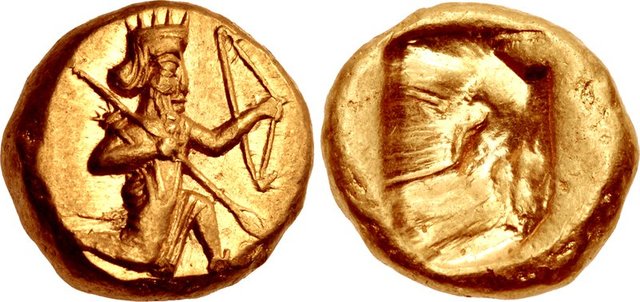
[ABOVE: A golden daric, minted at Sardis, 6th century BC]
All of this tribute alone gave King Darius around 14,560 talents worth of silver alone. Further smaller tributes would be taken in from the Greek world - namely the Aegean Islands and Thessaly. This vast amount of wealth was melted down by the king who stored it solid in jars, slicing off as much as he needed when he needed it. The only peoples of the empire that was exempt from taxation was the Persian homeland itself, and some smaller specially selected exempt groups like the Ethiopians, Arabs and various people of the Caucasus like Colchis who each made their own voluntary donations.
PEOPLE'S OF THE EMPIRE
THE INDIANS
The Persian Empire under Darius reached its territorial height, becoming the largest empire the world had ever seen at the time, so much so that it even encompassed parts of western India. So far east were they that Greeks who wrote of peoples of the world at the time didn’t know of any peoples that lived further than them; they were on the edge of the then-known world. India was inhabited by various tribes (some were even nomadic) who spoke several different languages. Herodotus described how some tribes lived in swampy marshes and lived off a diet of raw fish caught from boats made of a single piece of cane, which were oared by men who wore clothing made of rushes. The nomadic Padaei tribe were known to treat their ill by contacting the patient’s closest friends and having them kill him, thinking that if that person were to waste away then his flesh would be forever spoiled; A feast would follow after that person’s death, with the main food involved in said-feast being the deceased’s remains. They would also eat people who died of old age, although this was allegedly uncommon since people were eaten when taken in ill. Other Indian tribes were described to have other customs like only eating vegetables, not living in houses of any form and having sex in public spaces.
India was as far east as the Greeks and Persians knew of at the time, Arabia was as far south, Ethiopia was as far South-West and Europe was as far north and west.
Creatures known to both that lived in India were described as being larger than anywhere else in the world, and gold there was plentiful. Arabia was known as the only place where cassia, cinnamon, frankincense, myrrh and rock-rose resin, none of which (except myrrh) was said to be easy to obtain; The trees which produced the frankincense were often guarded by snakes, cassia was found in lakes guarded by aggressive bats, cinnamon sticks, used by large birds for their nests, had to be obtained by distracting the birds with lumps of meat too heavy for the birds’ nests to support, and rock-rose resin was taken directly from the beards of male goats. Ethiopia was known for its abundance of gold, elephants, exotic trees, ebony and people who were described as the tallest and most attractive known. The western extents of the rest of the then-known Europe were a little less known about. Herodotus, for example, did not know of the seas which bordered northern Europe, however Europe was the source of the Greek’s acquisition of amber, tin and even gold.
THE GREEKS
The Greeks who lived under Persian rule were treated no differently to the Jews: they also had gods of their own to be honoured and respected as per their customs. A Greek inscription from the second century AD has preserved a letter from Darius to one of his satraps:
“The king of kings Darius son Hystaspes to Gadatas his slave speaks thus: I understand that you are not completely obedient to my commands. Because you are cultivating my land, transplanting fruits beyond Euphrates to the parts of western Asia, I commend your diligence; and therefore great favour shall lie for you in the house of the king. But because you bring to nothing my work for the gods, I shall give you, if you do not change, proof of my anger when I am wronged. For you have levied tribute on the sacred gardeners of Apollo and you have ordered them to till profane land, disregarding the will of my ancestors towards the god, who has spoken all truthfulness towards the Persians…”
-- Greek Historical Inscription no. 12=35F
THE IONIANS
In some ways, Persia opened new opportunities for Greece; the empire’s unity of all lands from Anatolia to Persia made travel easier and allowed more trade opportunities to flood to the Greeks, and both of these aspects were aided further by the establishment of the Royal Road. However, the Ionians trade was primarily naval-focused, and the most skilled of traders made their way to Susa. Ionians also ended up in employment on the imperial buildings back in the cities of Pasargadae, Susa and Persepolis, becoming well known experts in stone working. They worked on paintings, graffiti and their masons’ markings in Greek reveal their works across the empire. A trilingual inscription in Susa of Darius shows the international characterisation of the forces at work there:
“The stone-cutters who wrought the stone, those were Ionians and Sardians. The goldsmiths who wrought the gold, those were Medes and Egyptians. The men who wrought the wood, those were Sardians and Egyptians. The men who wrought the baked brick, those were Babylonians. Those men who adorned the wall, those were Medes and Egyptians.”
-- Darius Susa F. 45-55 in Kent. Old Persian, pg.144
Persepolis’s treasury tablets in the early 5th century BC record the terms of service of the workforce, with two mentioning Greeks; the workmen there were in receipt of subsidy rations or silver in lieu instead of real wages. They were thus part of compulsory work there instead of voluntary labour. Opportunities offered by Persia had next to no monetary importance to the Ionians. They lost their outlet for their mercenary service; it’s likely that trade was hugely disrupted mainly thanks to the conquest of Egypt, and the campaigns into Thrace and Scythia.
IMPROVED IRRIGATION

[ABOVE: Rough diagram of a Qanat, an irrigation tunnel]
Darius’s improved irrigation system, originally in place since the reign of Cyrus, greatly expanded agricultural works, food surpluses and settlements throughout the empire’s largely parched land. These were irrigated thanks to “qanats” (irrigation tunnels) which moved water from underground water sources, and water bridges resembling the famous Roman aqueducts of later history carried more water to distant villages.
ROADS
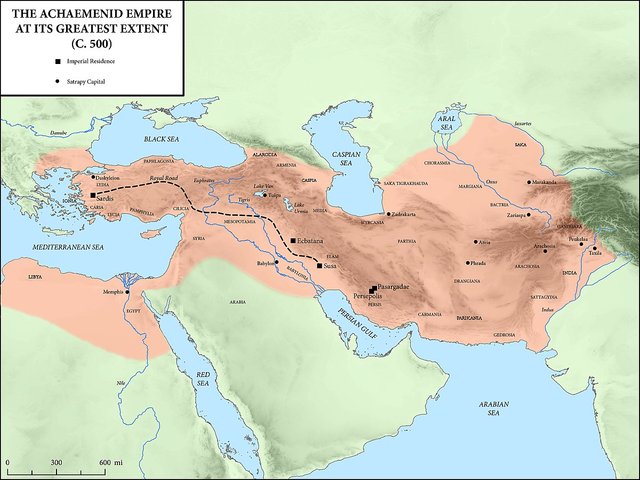
[ABOVE: The Royal Road, built under Darius, stretching from Sardis to Susa]
The eyes of the king, alongside trade caravans and soldiers, were easily and quickly transported across the empire via Darius’s new roads. The largest road built by Darius was the Royal Road, and it stretched from Ephesus in the west to Susa in the east, a distance of over 1,500 miles. It took trade caravans of donkeys and camels roughly three months to traverse, however royal dispatches could take around a single week thanks to a network of 111 equally spaced courier stations.
ZOROASTRIANISM UNDER DARIUS
Zoroastrianism became the state religion under Darius to provide the diverse citizens a sense of identity. This religion, however, was not enforced on anyone who was following another religion, and they were left to freely practice their customs and traditions as they pleased in their satrapies. This allowance of his citizens to keep their identity aided in stimulating trade and productivity. Living standards rose, Persian dominance in the region remained entrenched and Persia would go on to exist as a political entity for over a thousand years to come, up until the Muslim conquests of the seventh century AD, with several old Persian traditions still existing in use even today.
PERSEPOLIS: THE NEW CAPITAL CITY
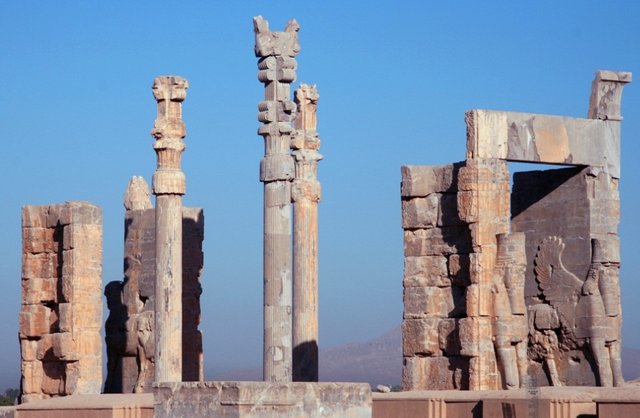
[ABOVE: The Gate of All Nations, Persepolis]
Persepolis was a palace-complex inaugurated by Darius in 518 BC, 37 miles away from the modern-day Iranian city of Shiraz. While construction begun under Darius, construction work was completed around a century afterwards by his successors. According to Plutarch, Alexander the Great, who invaded the Persian Empire in the 4th Century AD, required 5,000 mules and up to 20,000 camels just to transport the goods and treasures he found in the city itself.
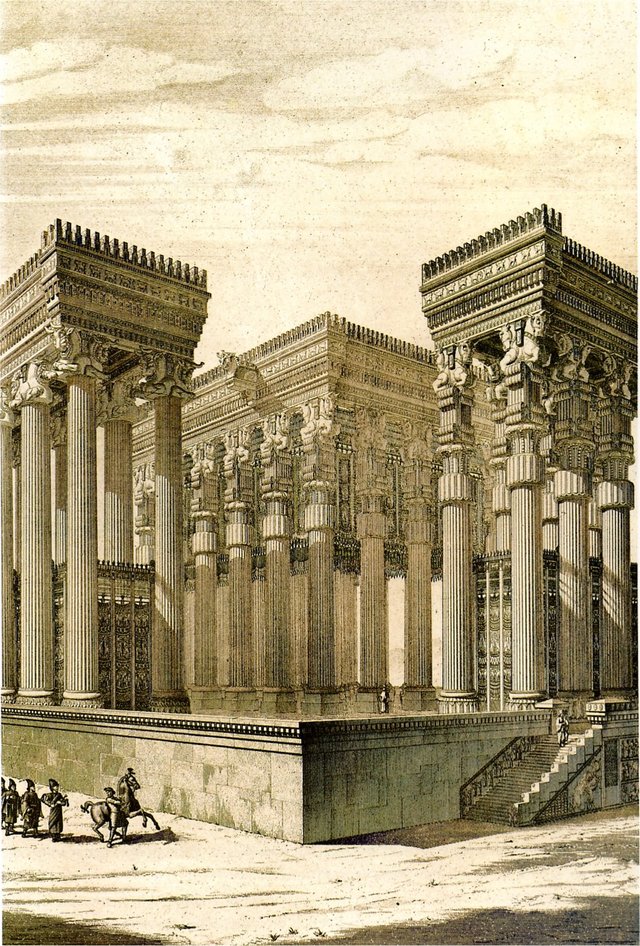
[ABOVE: Reconstruction of the Apadana reception hall, by French architect Charles Chipiez, 19th century]
Along a stairway which led to the reception hall (Apadana), engraved reliefs show envoys from all corners of the empire giving tributary gifts to the king himself. Among them can be seen Indians offering gold dust, and Bactrians from modern-day Afghanistan offering camels. Writings engraved on it showcases Darius’s great pride in his grand creation; he claimed the necessity to build the grand city was given to him by the gods themselves;
"And so I built it, and I built it secure and beautiful and adequate, just as I was intending to.”
DARIUS'S EXECUTION OF INTAPHRENES
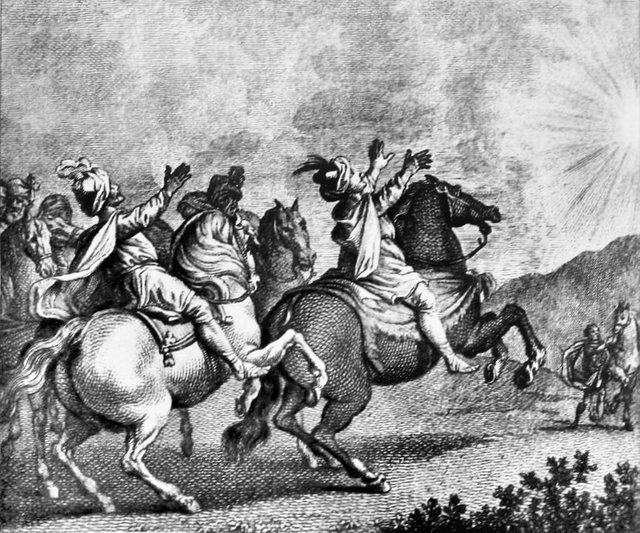
[ABOVE: Darius and 5 other Conspirators, including Intaphrenes, invoke the sun to become king. Art by Jacob Abbott, 19th century]
One of the Seven Conspirators, Intaphrenes, not long after the uprising he took part in, wanted to enter the Persian royal palace to partake in business with Darius. New rules implemented by Darius stated that any member of the Conspiracy of the Seven could indeed go in to the palace to see the king whenever they wished, unless the king was currently intimate with a woman. So while Intaphrenes thought it was thus his right to enter the palace at will, the gatekeepers would’t allow him to enter, claiming that Darius was currently in bed with a woman. Intaphrenes didn’t believe them though, so drew his sword, cut off their nose and ears and sent them to Darius. When they showed themselves to the Shah, fearing that the other Six conspirators had a hand in this, Darius sent for them to be questioned to see if they approved of what had just taken place. Eventually, Intaphrenes, and all his male relatives, were arrested and sentenced to death. When Intaphrenes’ wife approached, having broke down in tears, she was eventually allowed to save just one of them. She chose her brother, and not her husband or children, stating that since her parents were dead, she could never have another brother, but she could always get another husband and more children. Taking a liking to her response, Darius allowed her brother AND oldest son to live.
OROETES KILLS POLYCRATES
Around the same time of Cambyses’ illness, Cyrus’s governor of Sardis, Oroetes, wished to, unprovoked, capture and kill Polycrates, the tyrant of Samos. One reason for the attack may have been that Oroetes got into an argument with Mitrobates, governor of Dascylium, who boasted of his own achievements compared to Oroetes’, stating that Oroetes couldn’t even successfully conquer the tiny, neighbouring island of Samos, which had previously been taken over by Polycrates with only 15 hoplites. An alternate version to how this conflict began was that after Oroetes sent a message to Samos, the messenger found Polycrates laying on his couch, and treated their meeting with contempt as he lay facing the wall during the exchange, thus provoking Oroetes. Either one of these is supposedly the reasoning for Polycrates’ death.
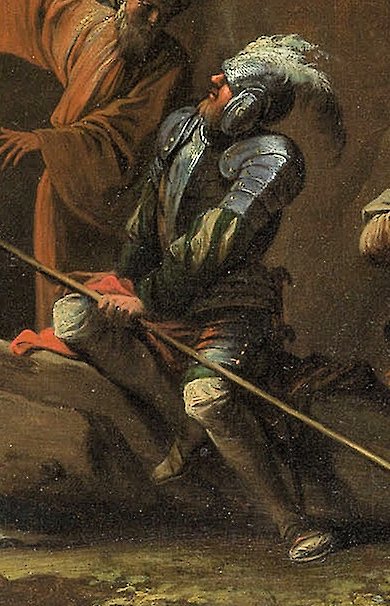
[ABOVE: Oroetes attending the crucifixion of Polycrates, by Salvator Rosa, 17th century]
Either way, finding out about Polycrates’ plans to dominate the seas, Oroetes sent a message to Polycrates, stating that he knew of his plans but also knew that he didn’t have the resources to pull off his goal, so asked that Polycrates rescued him from Cambyses, who wanted to kill Oroetes, promising him in return all his wealth to aid in funding his ambitions to conquer the Aegean Islands. In need of money, Polycrates was happy to get this message. Polycrates thus sent his secretary to inspect Oroetes’ wealth, and when Oroetes heard that someone was coming to make financial inspections, he had his treasuries filled near to the top with stones, covering the top layer with the few gold coins he actually had. The inspection was made, and the secretary returned to Polycrates to report his findings. Polycrates readied to visit Oroetes himself, despite warnings not to by both the Oracle and his own daughter. Upon arriving in Magnesia, Oroetes had him killed, and his body crucified. He then had all Samians in Polycrates’ company go free, but the same cannot be said for the non-Samians and slaves.
DARIUS KILLS OROETES
During the Magi Revolt, Oroetes remained in Sardis to not aid the Persians in reclaiming their own throne, using his spare time to murder his political opponents, including Mitrobates. As well as for other crimes Oroetes committed, Darius wanted the man executed. An open war against him in such unstable times was not the best idea, especially as Oroetes had a large bodyguard unit and governed strong provinces. So instead, he gathered the most prominent Persian figures to his palace, and in a long speech to them, he asked for a volunteer to capture Oroetes, via cunning instead of brute force, after having killed a governor and his son, and anyone Darius had sent for. Thirty men agreed to carry out the mission, and so eager were they to each carry out the king’s orders personally that Darius had to order them by lottery. Bagaeus, son of Artontes, won the lottery, and so begun writing letters on several issues, sealing them with Darius’s seal and taking these letters to Oroetes in Sardis. Arriving in Oroetes’ presence, he opened the letters in front of him one at a time and handed them to Oroetes’ secretary as such. Bagaeus handed these letters to see if any members of Oroetes’ personal guard would join him in taking him down. The guards respected the letters and their message, so Bagaeus gave another letter to the secretary, which stated that Darius forbade the guard from being the personal guard for Oroetes anymore. Hearing this, the guards dropped their spears, and Bagaeus, confident he had won the guards over, handed one last letter to Oroetes, which stated that Darius wanted the soldiers of Sardis to have Oroetes killed, to which they complied.
DEMOCEDES THE DOCTOR, DARIUS ADVANCES WEST
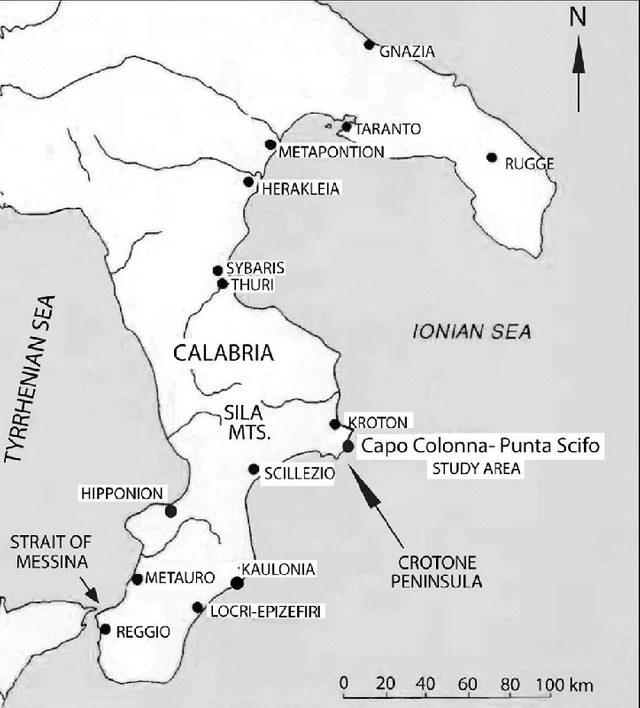
[ABOVE: The Greek colony of Croton (Kroton), southern Italy]
Returning to Susa, Darius sprained and dislocated his ankle while dismounting his horse while out hunting. Usually, Darius always had an Egyptian doctor at hand in case of such an emergency, and the ones he did have at hand only made his ankle worse. Seven sleepless days passed, and on the eighth, Darius was made aware of a man named Democedes of Croton. At the time, he was in a group sent to death among Oroetes’ slaves, and while still in chains and dressed in rags, Democedes was taken to see Darius, who asked him if he was indeed a professional doctor and asked the men who brought him to his presence to collect spikes and whips. To this, Democedes confessed his medical knowledge wasn’t as precise as hoped, yet he’d spent enough time with competent doctors to know what he was doing. Democedes’ gentle Greek techniques allowed Darius to catch up on sleep, and he was soon able to get back on his feet. The doctor was rewarded with golden shackles and a visit to Darius’s wives.
Democedes would eventually go on to live in Polycrates’ court; he was originally from Croton in southern Italy, but did not get along with his father, so left hastily for Aegina. Despite leaving with little professional medical equipment or knowledge, he quickly proved himself naturally medically inclined, quickly becoming an official physician on a salary, eventually being hired by Polycrates himself. After healing Darius, Democedes was granted a house, and became close to the king, eventually convincing him not to have Darius’s former Egyptian doctors be executed for failing to save him in the first place.
Eventually however, Atossa, Cyrus’s daughter and Darius’s wife, developed a growth on her breast. Democedes promised to take care of it, on the condition that she did whatever he asked of her, but nothing that would cause her great shame. Once she was made better, she did as Democedes asked; later, while in bed with Darius, she carried out Democedes’ wishes, and asked Darius why, with so much power, he had not expanded the empire’s borders. She argued that the people of the empire would feel more confident being under the rule of a strong king, and would be too preoccupied with expanding the borders to wish to conspire against him. He replied that he was already making plans to bridge Asia to Europe, and invade Scythia, but Atossa voiced her referral to first invade Greece, saying that their women make good servants in reward and that Democedes, being a Greek, would make a good guide. Darius agreed, and thus sent some men to Greece, along with Democedes, to bring back to their king a detailed report on everything they see there. Setting sail from Phoenicia, the other Persian met sailed across the Greek coast and noted and mapped everything they could see, until they eventually reached Tarentum in southern Italy. However, thinking they could be spies, the city’s king, Aristophilides, removed their ships rudders and imprisoned the Persians. Meanwhile, Democedes visited the Italian city of Croton, and once in his native homeland, Aristophilides returned his new prisoners and all their ships equipment.
Following Democedes to Croton, the now-free Persians attempted to seize him. The people of Croton were left split between letting the Persians take him, with some fearing the power of the Persian empire. Eventually though, the Crotonians got their way, and Democedes was abandoned by the Persians in Italy, and thus also gave up trying to learn anything else about the Greek world, which is what they had set out to do in the first place. Before leaving though, Democedes asked the Persians to tell King Darius that he had been arranged to marry the daughter of Milo, a famous wrestler, who’s name meant a lot in the Persian court. It’s likely that Democedes had the marriage arranged to show Darius that he meant a lot in his own country too.
On their way from Croton back to Persia, the Persian men were shipwrecked on Iapygia. They were eventually taken into slavery, but a Tarentine exile called Gillus had them freed and brought back to Darius, who asked him what he wanted as a reward. After explaining his exile to the king, Gillus said he wished to return to Tarentum, but this was unsuccessful as the people would not take him back. So much for these events: these Persian men were the first Persians to come to the Greek world, and they had come ultimately as spies.
--
In the next post, I'll be detailing Darius's expansion of the empire into the Aegean, Scythia, Libya and Greece. I've been working on Darius posts altogether a lot recently, so it will be out tomorrow.
Stay Tuned! :)
SOURCES
• Herodotus's "Histories"
• National Geographic's "The Most Influential Figures of Ancient History"
• Nic Fields' "Thermopylae 480 BC - Last Stand of the 300"
• Oswyn Murray's "Early Greece"
YOUTUBE LINKS
(I do NOT own these videos)
"DARIUS THE GREAT - PERSIA RISES PART 3 - ACHAEMENID PERSIAN EMPIRE", by "Yore History"
This has been the seventh part in many blogs on the Achaemenid Empire. Go and check out the rest if you haven't already:
THE PERSIAN EMPIRE
https://steemit.com/hive-133974/@oo7harv/the-persian-empire-history-s-first-superpower
CYRUS THE GREAT 1
https://steemit.com/hive-133974/@oo7harv/cyrus-the-great-conquests-of-media-and-lydia
CYRUS THE GREAT 2
https://steemit.com/hive-133974/@oo7harv/cyrus-the-great-2-conquest-of-babylon-and-his-downfall
CAMBYSES II
https://steemit.com/hive-133974/@oo7harv/cambyses-ii-heir-to-cyrus-the-great-530-522-bc-part-1
CAMBYSES II 2
https://steemit.com/hive-133974/@oo7harv/cambyses-ii-the-mad-persian-shah-530-522-bc-part-2
CONSPIRACY OF THE 7
https://steemit.com/hive-133974/@oo7harv/the-conspiracy-of-the-seven-from-cambyses-to-darius
PERSIAN PROVERBS
https://steemit.com/quotes/@oo7harv/persian-proverbs
THE HISTORY COMMUNITY
https://steemit.com/created/hive-133974
All feedback - positive and/or critical - is appreciated!
Don't forget to rate this post and leave a tip if you enjoyed it
Thanks for reading :)